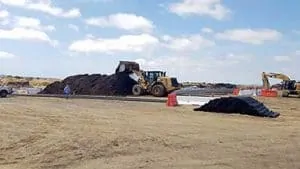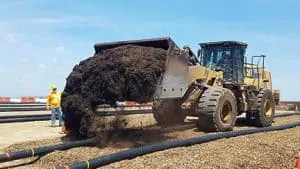

Sustainable Materials Management (SMM) at the Miramar Landfill, San Diego, CA
Background
The City of San Diego’s Environmental Services Department (ESD) strives to provide high-quality solid waste disposal services for the citizens of San Diego and the greater San Diego metropolitan area. The City’s goals were to divert organics from the Miramar Landfill Complex to reduce greenhouse gases (GHGs), thus meeting mandatory state requirements.
Based on a waste characterization study, San Diego felt this was an opportunity to organize and support local food reuse programs in the non-profit sector; thus creating two integrated programs to meet their goals to divert 100,000 tons per year of organic material from the landfill and reduce GHGs. The programs include one focusing on diverting foodstuffs to the non-profits; the second, to design-build and implement the Sustainable Materials Management (SMM) infrastructure.
The City required a team knowledgeable in waste management planning, sustainable materials management, composting, economic analysis, landfill gas monitoring and capture, renewable energy, local, state and federal regulatory policy, along with the construction, implementation, and monitoring of the new composting infrastructure.
San Diego selected SCS Engineers to provide these comprehensive services because of the firm’s knowledge of Miramar’s infrastructure, operations, and their leadership role in providing sustainable systems, which decrease the amount of landfilled solid waste and create useful by-products. SCS is also supporting the City’s investigation into using Miramar’s landfill gas as a renewable energy resource to reduce further carbon emissions.
Challenges

SMM projects require careful planning, strong leadership, and effective teamwork. The City was well organized; SCS structured its multi-disciplinary team accordingly to meet all goals. Due to the complex nature of individual infrastructure segments, each team could reach out to additional resources within SCS for specific expertise as needed.
Truly sustainable programs address multiple factors, including all of the costs associated with reaching recycle-reuse-reduce goals, so controlling cost is always important.
Outcomes and Benefits

SCS’s multi-disciplinary teams provide coordinated support for infrastructure improvements, design-build, organics management, SMM, as well as regulatory compliance. SCS helped San Diego meet their goals of diverting 100,000 tons of organic materials and food waste per year. Sanitary food rescue programs supported by non-profit food distribution channels provide for local community needs.
SCS design-constructed and implemented an Aerated Static Pile (ASP) Composting System. Mounting semi-impermeable covers for organic materials during installation, and providing composting and above-grade aeration generated immediate and sustainable GHG reductions. The SCS system diverts waste from the landfill, composts 40,000 tons into useful by-products, and extends the life of the landfill. SCS designed the system so that it can expand by 20,000 tons.
According to the StopWaste.com calculator, San Diego is accomplishing the greenhouse gas emissions equivalent to taking 19,015 cars off the road every year. San Diego now has a viable compost by-product to sell from the Miramar Greenery located at the landfill.
The AST system was also designed-built to provide an enhanced stormwater control system for green and food waste operations, improving soil and water conservation and decreasing the possibility of odor nuisances.
SCS provides operating, maintenance, and monitoring (OM&M) services to the entire Miramar Gas Collection and Control System (GCCS) on behalf of the City. This responsibility requires a team of field technicians, who work closely with SCS’s engineering and air compliance teams to support the air quality compliance work (surface monitoring, well readings, full equipment maintenance, servicing, and all regulatory reporting) and enhances the design-build of infrastructure.
Future Benefits
San Diego is investigating running the AST system on renewable energy generated from the existing landfill. Traditional programs use a GCCS to capture and destruct landfill gas (LFG), which is about 50 percent methane and not released into the atmosphere.
Modern programs, such as the one San Diego is investigating capture LFG and turn the methane into energy/electricity, or use it to make Compressed Natural Gas (CNG). CNG, which is a green, renewable fuel source, is useful for many things, including transportation fuel for a variety of vehicles such as refuse trucks, transit buses, and heavy equipment.